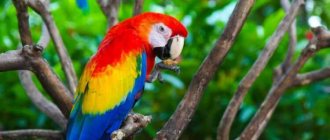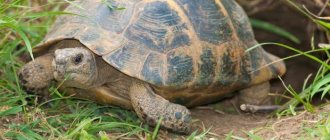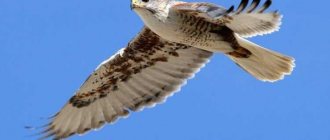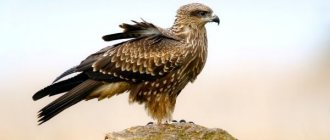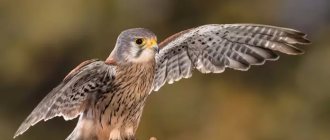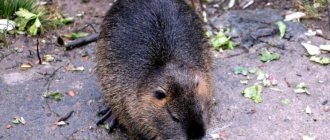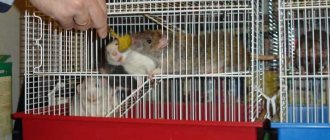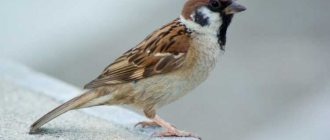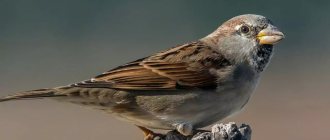Review author: “ZooVita”
The dwarf fold ram is the most popular breed of decorative rabbits. A cute animal with a charming face, cute floppy ears and a calm character, it is most suitable for children and beginners.
From the outside, a rabbit may seem like a toy, but it is a living creature that requires attention, care, and responsibility from its owner. In return, the handsome furry man is able to give love, devoted friendship, and a lot of pleasant emotions.
Before purchasing an animal, you need to study its habits, behavior, know what to feed a dwarf rabbit, and how to care for it.
What signs can be used to determine the age of a rabbit?
There are several ways to determine the age of a rabbit by external signs.
For a beginner, this may seem difficult, but with careful and careful study of the animal, you can quickly figure out the issue. You need to learn how to determine the age of rabbits immediately upon purchasing them in order to avoid deception on the part of the seller. First of all, the condition of the teeth of any animal is checked. However, this method is not informative enough, because it gives a rather expanded range.
The teeth of a young rabbit are smooth and light. With age, teeth wear down and darken, and the enamel often becomes stained.
The teeth can be used to determine the age of a rabbit in the range of up to a year or more than a year. In individuals that are more than a year old, the teeth acquire a dark coating. It is almost impossible to determine a more specific age of an animal from its teeth.
Ribs
The ribs can be used to determine the age of an individual in the range of up to six months or more. Regardless of the size of the animal, the ribs of a young rabbit are thin and soft, like cartilage. Rabbits that are more than six months old have hard and elastic ribs.
Claws
Claws often become the main method of “rejuvenating” rabbits for a more profitable sale.
It is important to know the following features and principles of self-determination of age:
- From birth, rabbits' nails are transparent and thin, they can bend when pressed;
- by the age of six months, the claw bends, becomes slightly cloudy and hardens;
- With age, the claws become stronger and acquire a shade corresponding to the color and breed.
Unscrupulous sellers use a simple method of “rejuvenating” rabbits by cutting their claws before selling them.
Eyes
You can also determine the age of an animal by its eyes.
Why you need to study the following information:
- age is determined by the appearance of the upper eyelids;
- in rabbits, the upper eyelids are even and uniform, of the same color;
- the upper eyelids are small at first, but with age they begin to increase in size and sag;
- in adults - aged 6 months and older - the eyelids acquire a characteristic tuberosity, acquire a gray tint and sag;
- Juveniles have clear, brightly colored eyes;
- With age, the lens of the eye becomes cloudy.
The eyes of rabbits should also be examined before purchase to identify any diseases. Often in animals, infectious lesions are manifested by increased lacrimation.
Wool
More accurate information about the age of a rabbit can be provided by the condition of the fur, which undergoes the following changes:
- the appearance of the brood occurs without hair - only after reaching a week of age do the rabbits become covered with thin fluff;
- fur begins to appear at the age of 2 weeks from birth;
- upon reaching 1 month from birth, the first molt begins: it lasts at least 2 months, just when breeders sell animals;
- During the first molt, the fur loses its bright color and falls out, forming characteristic white bald spots, and in places where the fur still remains, the color is gray.
Immediately after molting, the animal begins to acquire permanent hair, with which it lives for the rest of its life - it partially changes during subsequent molts. At the age of 3-4 months, the rabbit gradually acquires soft and thick hair.
If, when selling adult rabbits, the seller assures that they are no more than 4-5 months old, and at the same time the rabbit’s fur falls out or has an unhealthy appearance, then his deception will be obvious to the buyer.
Readiness for mating of a female and a male
As a rule, males begin to show interest in females at the age of 3 months and older, while they may still be fragile after birth. Females reach sexual maturity only at 6-7 months from birth.
You can check the female’s readiness for mating by running your hand along her back in the area just above her tail. If the female rabbit is ready, she will make it clear by her reaction - she will stand in a position that allows the male to crawl up. But it is not recommended to start breeding rabbits at this age. Females must reach sexual maturity, which occurs between 9 and 11 months of age. In males it occurs between 8 and 10 months.
It is also important to pay attention to the condition of the genital organs. The external sexual characteristics of rabbits are formed by 3 months from birth. Adults who have already completed the mating process are distinguished by more obvious forms of genital organs
Adults who have already completed the mating process are distinguished by more obvious forms of genital organs.
How to extend lifespan?
For a rabbit to live a long life, it is important to show it love and care. When purchasing a baby rabbit, you should ask about its pedigree, who its father and mother were, what kind of health they had
Knowing what diseases the pet is predisposed to, the owner will be able to pay attention to prevention, working in the right direction.
You can protect your animal from diseases if you vaccinate on time. Vaccinations will help prevent life-threatening infections for your pet.
This is especially important to do if the owner plans to walk the pet outside on a leash.
Physical activity is beneficial for a decorative rabbit. In order for the rabbit to lead an active lifestyle, you should choose a spacious cage, and place ladders, tunnels, and a wheel inside it. It’s good if the animal spends at least an hour and a half a day outside its cage, walking around the apartment, and even better - in the fresh air. These are the main rules thanks to which the decorative rabbit will be healthy and be able to live a long life. Let’s consider what else will help prolong your pet’s lifespan below.
Keeping it clean
The cage is cleaned regularly, cleared of droppings, the floor, bars and trays, drinking bowls and feeders are disinfected. The room where the pet's cage is located should not be dusty. You need to wash the floor and wipe the furniture with a damp cloth.
The cage must be perfectly clean
It is important to keep the animal’s fur clean and comb it out so that tangles do not form. This is especially important during shedding.
If you do not comb the fur, the rabbit, while licking itself, will eat the hair, as a result it may die from intestinal blockage.
Conditions of detention
Rabbits are sensitive to drafts and dampness. When an animal is in such conditions, its immunity decreases. A cold can lead to the death of an animal. Rabbits also do not do well in hot and stuffy rooms. The cage should not be located on the windowsill so that the pet does not suffer from drafts and overheating in the sun.
Nutrition
In addition to feed, the animal’s diet includes good quality hay, vegetables, herbs, and tree branches. In winter, it is worth strengthening his immunity with vitamin and mineral supplements. You can't feed a rabbit:
- sausages;
- meat;
- sweets and pastries;
- wet grass;
- poisonous plants;
- moldy hay;
- rotten vegetables.
Safety
It is recommended to install the pet’s cage on a hill, that is, on a cabinet or table
It is important to ensure that the door is securely fixed so that the rabbit cannot open it itself and fall down. It is unacceptable to drop the animal or step on it: it may die from injuries
The rabbit's place must be safe.
Protection from stressful situations
Do not expose your rabbit to stress. It is better to protect it from collisions with other pets that may frighten the animal. You should not shout loudly in the presence of a decorative rabbit, or use a drill or vacuum cleaner.
Treatment
If your rabbit is sick, you should immediately contact a veterinarian rather than try to cure it yourself. Some diseases develop rapidly and can kill an animal very quickly. Do not neglect routine vaccination.
How long a decorative rabbit will live at home depends in most cases on its owner and on what living conditions he provides for the animal. When purchasing an animal, you need to be ready to give it love and care, spend time and money on treatment, play and walk with the rabbit. Then he will live a long life.
What affects weight gain
In addition to genetic data, a properly formed diet is important. It includes different types of feed, vitamins and minerals. Rabbits have a very unique digestive system (food should always be in the gastrointestinal tract), so they are fed in small portions several times a day: 4 times for a nursing rabbit and newborns, for other animals 2-3 times are enough. But there should be hay in the cage all the time. Access to clean drinking water is provided freely.
For the normal functioning of the gastrointestinal tract, it is necessary to adhere to the chosen diet and avoid sudden changes in food. Of the vitamins, special attention should be paid to A, D, C, E, B.
There are special additives - growth stimulants. They not only accelerate weight gain, but also strengthen the immune system and build resistance to diseases. The dose of such a drug is calculated based on the nutritional characteristics and age of the animal.
The growth of rabbits depends on their physical condition. To maintain the health of individuals, they organize comfortable living conditions, adequate care, and maintain high-quality nutrition.
Growth rate
Changes in little rat pups are observed daily:
- On the 3rd day the ears appear.
- Teeth appear on days 8-10.
- After 2 weeks, the nipples of females become visible.
- In the third week, the eyes open and the body becomes covered with fur.
The period of childhood in animals is very short, which is confirmed by the following:
- Within 10 days, the pups grow to the size of an adult mouse.
- After a little more than three weeks, the animals begin to feed on their own.
- After 30 days, the cubs leave the parental nest.
Subsequently, the rats grow until the age of 6 months. After this, they gradually mature and reach their maximum size at about a year.
Food for dwarf rabbits at home (diet)
The diet of the dwarf fold consists of hay and grain mixtures, which can be purchased at a pet store. Animals should also receive sufficient amounts of vitamins and microelements. It is important that the animal always has fresh water.
Adults are additionally given fruits, vegetables, branches, and bark. Tomatoes, cabbage, and beets are given carefully so as not to cause intestinal upset. A useful addition to the main diet is mineral stone.
Reproduction
If you have already purchased a purebred individual, you can use it for breeding - this is useful for the animal itself, and allows you to give a fluffy bundle of happiness to your loved ones, and leaves opportunities for good earnings.
Female rabbits become ready to mate early - it is usually recommended to mate them for the first time even before the animal is one year old. It is quite easy to determine that the animal is ready and needs the company of the opposite sex, since the pet’s behavior changes radically - now the female behaves restlessly and is easily irritated. If you have at least once observed the life of rabbits, then you know that they do not need much time to mate - once they are mutually accessible, they almost immediately get down to business. The animals are left alone for a short time, after which they are seated, but the procedure is repeated the next day - this must be done just in case, so that the rabbit definitely becomes pregnant.
The duration of pregnancy in dwarf rabbits depends on various factors, but usually it is exactly one month. At the same time, a large number of cubs usually leads to a fairly early birth, but a small litter, even consisting of fairly large babies, is often slightly delayed.
Caring for a pregnant female is somewhat different - you need to approach the principles of menu formation differently. If in the first two weeks of pregnancy no noticeable differences are observed, then by the third week the rabbits growing in the womb require more and more calories, so the dosage is increased slightly. At the same time, it is undesirable to overfeed a rabbit, because these animals are prone to gaining excess weight, which ultimately leads to health problems. At the same time, it is worth slightly increasing the dosage of cucumbers, as well as some other vegetables and fruits, since, according to some experts, they have a beneficial effect on milk production.
Newborn babies do not hear or see anything, they are strictly forbidden to be separated from their mother - at this stage, only she herself can fully care for them. The person’s task now is to provide a warm place, since even just on the bare floor the babies will die, and to increase the diet for the rabbit.
The behavior of a mother rabbit may seem strange to inexperienced people. First of all, such a mother does not sit around her cubs, but there is nothing unusual in this - even in nature, she would leave them in the hole, while she herself went to look for food for herself in order to produce milk. Despite the fact that you feed the animal and it no longer needs to search for food, the instinct does not go away, so the female only visits the babies indoors, otherwise trusting their will of fate.
At the same time, the owners must closely monitor that the rabbit never remains hungry. The fact is that this peaceful herbivore, being hungry, can easily eat its own cubs!
A proper diet is the key to health!
I will repeat a common truth, which, however, most rabbit breeders lose sight of: rabbit food must be perfectly balanced. As experienced rabbit breeders say: If you feed only hay, the rabbit will only grow ears. Translating into a more scientific language, I will say that the speed of weight gain and the condition of the gastrointestinal tract of animals depend on the quality and calorie content of food.
Feeding only hay is an extremely low-calorie diet that will support life and healthy intestinal motility. To gain weight, animals need to be fed grain bait, whole grain or crushed grain. In addition, they are given mineral supplements and soft food. Instead of creating a menu manually, it is easier to purchase ready-made feed - a balanced mixture of grains, bone meal and minerals.
A varied diet is the key to the health and rapid growth of a rabbit.
Minerals are especially needed by breeding animals and those breeds that are raised for fur. Grain mixtures containing legumes, corn, sunflower or rapeseed are available for sale. These supplements are high in calories and promote weight gain.
There are foods that are contraindicated for animals:
- fresh grass on which pathogenic bacteria are present, because in 95% of cases, epidemics that can destroy livestock in the territory of an entire village are transmitted precisely through fresh leaves;
- some types of plants containing toxins: foxglove, lily of the valley, henbane, colchicum, lumbago, buttercup and others;
- branches of stone fruit trees and the essential oils they contain are toxic to animals;
- bread crumbs can clog the intestines, which leads to the painful death of animals within 24 hours.
How to toilet train an animal
Accustoming a baby rabbit to a litter tray requires a lot of patience from the owner.
The little rabbit is gradually getting used to the toilet, but you will have to be a little patient. It is advisable to remember in which corner the breeder had the tray and place it there at home. It is worth asking the breeder for some used litter and mixing it with the old one. The pet will quickly find its native smell.
If the baby doesn't get into the tray, there's no need to swear. As soon as it becomes noticeable that your pet wants to go to the toilet, you must immediately put him in the litter tray. After a job done successfully, the animal should be praised. If you patiently train your pet to use the toilet day after day, the result will be achieved.
How many years do decorative rabbits live?
The average lifespan of domestic rodents is 8-10 years. Dwarf rabbits live a little less - 7-8 years. Much depends on the conditions in which the animal is kept. With good care, long-eared pets rarely die before the allotted time.
The lifespan of an animal is influenced by the following factors:
A caring owner can prolong the life of his pet. What is needed for this:
The approach of old age is indicated by changes in the behavior of the decorative rabbit. Over time, his activity decreases, he ceases to be interested in games. In older animals, their fur thins, their eyes become cloudy, and their muscles weaken. But we must remember that in old age a pet needs the love and care of its owner even more.
List of breeds
Decorative miniature rabbits are so popular that breeders from different countries have bred a good two dozen breeds in just over a hundred years. Their names won’t tell an ignorant person anything, but if you decide to choose a beautiful and furry friend for yourself for many years to come, it’s worth understanding how individual species differ from each other. Let's take a brief look at the most common breeds.
The Dutch, also known as the Danish or Netherland rabbit, is the first colored breed, which made these animals incredibly popular. By the way, he is not so small - with a weight of about 2.5 kilos, he is simply a giant compared to other miniature brothers. It is recognized by a white wedge on its muzzle, pointed upward; at the bottom it turns into a white chest and the same front legs. The sides of the head, ears and back of the body are colored in a different tone, for example, black, blue or chocolate, the line of demarcation of colors is clearly visible. These calm animals learn well and live for about 10 years.
Record holders among long-eared animals
Ralph Rabbit's story is like a roller coaster. Paulina Grand's ward is considered the largest. But doctors are seriously concerned about the pet’s well-being. Today, the weight of the big-eared celebrity is 22 kg, although the owner assures that she provides the rabbit with physical exercise. However, the giant is outwardly active and does not show any dissatisfaction with its maintenance or care. The body length of the playful domestic hare is 130 cm.
Darius is another former Belgian breed record holder. In 2010, he even managed to dislodge Ralph, however, after that he lost ground with a weight of 19 kg. His owner, Annette Edwards, had previously registered large rabbits in the Book of Records; they were the parents of Darius. Apparently, the hereditary factor played a huge role in this particular case. The length of the body in 2010 was inferior to the current leader. True, according to some reports, the pet will soon snatch the palm from Ralph again. The owner claims that the rabbit gained weight 22.2 kg and grew to 130 cm.
Jeff is the son of Darius, so it is not surprising that the whole world expects big victories from him. Annette, as a specialist in breeding ornamental breeds, is confident that Jeff will become a record holder. Now the rabbit is 3 years old, but its body length is already 95 cm. Miss Edwards is happy to tell the secret of such success in an interview. First of all, this is a balanced diet, as well as physical exercise. For example, Darius’s weight, as Annette admits, is largely determined by muscles. He is very active, runs constantly, and his caring owner spends the lion's share of her financial resources on quality maintenance. The price of good food for large breeds is high, which forces the farmer to turn to relatives for help.
Preparing the site
If a miniature stick-eared animal appears in the house, it is worth preparing a place for it. It should be located at a great distance from the battery and air conditioner. Animals cannot tolerate heat, drafts and direct sunlight. The dwelling is installed in the shade in that part of the room that is not blown through during ventilation.
Keeping dwarf rabbits at home can be in cages or enclosures. The first option is suitable for a small apartment. Cells must meet the following requirements:
- All parts of the cage must be made of special durable plastic or metal so that the animal does not chew them.
- The dwarf domestic rabbit and the length of the cage must be proportionate; the house chosen is 4-5 times the size of the pet.
- Optimal walls are created from a dense mesh, and not from ordinary parallel rods.
- A deep plastic tray is placed at the bottom to make cleaning easier. The mesh floor is not very comfortable; the animal can injure its paws on it.
- A litter tray is placed in one corner. It is better to take a heavy metal one so that dwarf rabbits do not turn it over. Plastic trays are fixed with special fasteners to the bars of the cage.
- On the opposite side of the tray they make a small closed house where the animal can hide and sleep.
- A manger for hay is attached to one of the walls of the cage.
- Containers for wet food and grain are installed inside.
- The drinking bowl is hung next to the feeder.
- A closed pipe, balls and other toys must be placed in the cage.
If there is enough space in the house, they create an aviary. To do this, part of the room measuring 1.2 × 1.3 m is fenced off with a mesh. The optimal height of the screen is 1 m. A waterproof piece of linoleum or thick film is placed on the floor. The top is covered with straw mixed with shavings. An iron tray is placed in the far corner. The enclosure should also have a buried sleeping house, crawling tubes, a wheel and other toys. A manger with hay and an automatic drinking bowl are attached to the net, and bowls for wet food and grain are placed nearby.
Content
Once you have at least approximately decided on the choice of a furry pet, you need to start thinking about keeping decorative rabbits.
Where to start? To begin with, from the premises. They live in an ordinary room at a standard temperature
It is important that it is not wet or with a lot of drafts - this is unacceptable for decorative rabbits
The room needs to be cleaned regularly, just like the cage. A dusty and dirty home can cause many diseases. It’s a similar story with sunlight - it should be there, just not direct rays, especially not constant ones.
If you want your rabbit to live freely in an apartment, albeit with its own cozy corner, pay attention to everything that it can chew, because you can be sure that it will try. Rabbits chew on anything they can put in their mouths, and the wires are the first to suffer.
It is best to keep him in a cage, and when releasing him, carefully monitor him so that he does not do anything. Do not forget that if he tries to chew the wires, it can harm not only the equipment, but also the animal - the wire may be live.
Sizes: furry giants and babies
During selection, two hundred breeds of animals were bred, and they all differ not only in characteristic habits, color and length of fur, but above all in weight and size.
Breeding standards
The range of values is so wide that all domestic rodents are classified into four main groups:
- Dwarf breeds grow up to 20 cm. Dwarf. For the smallest, dwarf breeds, the standard weight is from 1 kilogram to one and a half. Animals weighing 1.3 kg and measuring no more than 20 cm have an ideal proportion.
- Small ones. The main distinguishing feature of a small ornamental animal from an ordinary meat rabbit is its relatively small weight. An adult rarely exceeds the limit of 2 kilograms with a body length of 25 to 30 cm.
- Average. Rabbits of this group, when growing up, quickly gain weight up to 4 kg, and the length of the body extends to 57 cm.
- Large ones. Real giants, striking the imagination with their accumulated mass. The record weight is 8 kg, and the size of the carcass reaches 70 cm.
Eared giants
Among some breeds, animals of truly outstanding size stand out:
- Eared giant. English fold. The breed is considered the oldest and remains the most popular in England. The weight of an adult giant rabbit reaches 5.5 kg.
- French Fold. At the end of the 19th century, a new breed was obtained by crossing the English and French rabbits, the representatives of which grow up to 6.8 kg.
- Dutch, the weight of the animal reaches 5 kg.
But the real giants are the rodents bred by Soviet breeders in the middle of the last century. Combining the desire to obtain animals with high vitality, precocity and excellent health, scientists crossed the English breed of large animals with local ones, which were distinguished by their large body weight. Thus, scientists obtained giant rabbits with good genetic characteristics:
- Breed Gray giant. Gray giant. The average weight of an adult animal is 4-6 kg, and record-breakers weigh more than 7 kg.
- Soviet chinchilla. The weight of an adult animal reaches 5 kg; for particularly large rabbits it is 7–8 kg.
The leading place in terms of size is occupied by the Belgian Flanders. A long rabbit, growing up to 70 cm, with thick, luxurious fur. Ordinary animals weigh from 7 kg, some grow up to 10-12 kg, and the recorded record is 25 kg.
Minilop
Minilop is a lop-eared rabbit. However, this breed's ears do not droop as much as those of Lambs. Babies are very reminiscent of a plush toy. The breed is quite difficult to breed. It is lightweight - up to 1.3 kilograms. The body of rabbits is quite massive, the head from the side looks like a ball. The color can be varied, the wool is thick and thick. Minilops are very playful and friendly animals, so they are quite popular among lovers of such animals.
Lion-headed individuals got their name for the specific growth of their fur.
Refusal to feed
Reluctance to feed born offspring may have various reasons. Among them:
Mastitis. Painful sensations associated with inflammation of the mammary glands and hardened nipples can completely discourage a rabbit from breastfeeding. When a disease occurs, the animal needs timely assistance, which guarantees a return to a normal rhythm of life. It is better to confirm suspicions of mastitis with a diagnosis from a specialist who will prescribe the necessary procedures. If mastitis is diagnosed, children should not bother their mother; this must be monitored. Pain when trying to latch on gets worse and becomes the cause of aggression towards the offspring. Schematic representation of mastitis
Hormonal disbalance. Too active behavior of the female the very next day after giving birth indicates a desire to mate. She moves dynamically, chews hay and tears the fluff on her chest. In this state, the animal is dangerous for its offspring; it should be placed in a cage with a male. Usually, after mating, the female calms down and is ready to continue performing maternal duties. A female rabbit needs mating if she actively chews hay the day after giving birth.
External stimuli. Too loud sounds, bright lights, or excessive interest from strangers in the offspring can frighten a young mother and cause a lack of milk. To prevent such a situation, the rabbit needs complete rest before and after giving birth.
Lack of maternal instinct. The phenomenon can be recognized in advance by the behavior of the rabbit before giving birth. Females with weak maternal instincts usually show no desire to build a nest for their offspring. By observing the female rabbit, you can predict possible abandonment of the cubs and prevent aggressive actions.
At best, such a female will simply not pay attention to the newborns; at worst, she will try to bite them to death.
A female rabbit may ignore newborns without showing maternal care.
Features of behavior
Domestic rabbits communicate with their owners using body language. By carefully observing your pet, you can guess what he wants to say:
The habits characteristic of most rodents are described above. However, each animal has its own character, so the behavior of decorative rabbits under different circumstances may differ.
What meat breeds
All rabbits intended for slaughter for meat must comply with GOST. All animals are divided into groups:
- First:
it is usually divided into the first and second subcategories. Animals of this group have well-developed muscles, the dorsal vertebrae are weakly palpable and practically do not protrude, and the hips are well developed and rounded. Fat deposits can be easily felt on the withers, belly and groin. - Second:
in animals the muscles are slightly less developed, and the spinous processes of the dorsal vertebrae protrude slightly. Representatives of the second group have toned thighs, a slightly flat butt, and may have no fat deposits. - Third:
this group includes animals with poor muscle development and protruding vertebrae. They are considered skinny and are not suitable for breeding for meat. Figure 3 shows the main defects that make animals unsuitable for slaughter for meat.
Figure 3. Possible external defects of individuals The hair should not be dirty, tangled or in the stage of active molting. Females should not be in the last stage of pregnancy.
Broiler rabbits belong to the first category, and their fatness must meet the following requirements:
- Dense and well developed muscles, thighs and rump;
- The spinous processes of the dorsal vertebrae are palpated;
- You can feel small fat deposits on the withers.
Animals intended for slaughter for meat can be transported by any type of vehicle, but in accordance with existing rules for transporting animals and poultry in containers, boxes, metal or wooden cages.
Meat rabbit breeds that are suitable for breeding include
(Figure 4):
- New Zealand White:
weight reaches 6 kg, and in one litter the female gives birth to 7-12 cubs. Their soles are down, so the breed can be raised on mesh floors. - New Zealand Red:
females are much larger than males, and after birth, the cubs quickly gain the weight required for slaughter. - Gray giant:
adult weight 5-6 kilograms. The female gives birth to 7-8 cubs, which are distinguished by their precocity, rapid growth and good weight. The meat is of average quality. You can also get large skins. - The Californian breed
is characterized by rapid growth and weight. During the year, the female gives birth to 30-35 rabbits. The skin is of high quality, with thick and dense wool, the meat has a high taste. - European Silver:
animals of this breed are not picky, have a calm character, require a minimum of feed, and tolerate severe frosts. The skin is thick and soft. - Poltava Silver
is a breed that allows you to get juicy and tasty meat. The fur is fluffy and valued for its color. Animals tolerate frost well.
Figure 4. Popular meat breeds: 1 - New Zealand white, 2 - New Zealand red, 3 - gray giant, 4 - Californian, 5 - European silver, 6 - Poltava silver
